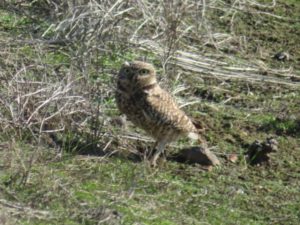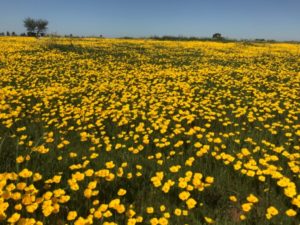


Area: 1,342 acres
Location: Sacramento County
Acquisition Type: The Preserve is owned by the County of Sacramento. CNLM holds a Conservation Easement (CE) over a 224-acre portion of the Preserve. The County recorded a Declaration of Covenants and Restrictions on the remaining portion of the Preserve–1,118 acres. CNLM is named as a limited third-party beneficiary on the deed restriction and thus assists the County in protecting and enforcing conservation measures on that part of the Preserve as well as the CE area.
Key Habitats: Vernal Pool, Riparian, California Annual and Perennial Grassland
Species of Special Interest to CNLM: Swainson’s hawk (Buteo swainsoni), vernal pool fairy shrimp (Branchinecta lynchi), vernal pool tadpole shrimp (Lepidurus packardi), western spadefoot (Spea hammondii), Sacramento Orcutt grass (Orcuttia viscida) (introduced), Boggs Lake hedge hyssop (Gratiola heterosepela), Ahart’s dwarf rush (Juncus leisosperus var. ahartii),Legenere (Legenere limosa), and western burrowing owl (Athene cunicularia hypugaea)
Introduction
 The Illa M. Collin Conservation Preserve, previously known as the Mather Preserve, was established according to the 2012 U.S. Fish and Wildlife Service (USFWS) Biological Opinion for the Disposal of Mather Air Force Base for the purpose of protecting, in perpetuity, sensitive and high-value vernal pool habitat and associated listed species. The protection of these conservation values is further ensured through the use of protective legal instruments and management by a professional conservation organization. A Wetland Management Plan for this property was drafted and completed in 2014 with comments from and with approval by USFWS, California Department of Fish and Wildlife, US Environmental Protection Agency, and the US Army Corps of Engineers through a process that also included the County of Sacramento expert review, and public input. CNLM was selected to manage the Preserve in October 2015, was contracted to provide some specific management tasks in April 2016, and entered into a longer-term management contract with the County of Sacramento in February 2017. CNLM managed the Preserve for eight years, from 2017 through 2024.
The Illa M. Collin Conservation Preserve, previously known as the Mather Preserve, was established according to the 2012 U.S. Fish and Wildlife Service (USFWS) Biological Opinion for the Disposal of Mather Air Force Base for the purpose of protecting, in perpetuity, sensitive and high-value vernal pool habitat and associated listed species. The protection of these conservation values is further ensured through the use of protective legal instruments and management by a professional conservation organization. A Wetland Management Plan for this property was drafted and completed in 2014 with comments from and with approval by USFWS, California Department of Fish and Wildlife, US Environmental Protection Agency, and the US Army Corps of Engineers through a process that also included the County of Sacramento expert review, and public input. CNLM was selected to manage the Preserve in October 2015, was contracted to provide some specific management tasks in April 2016, and entered into a longer-term management contract with the County of Sacramento in February 2017. CNLM managed the Preserve for eight years, from 2017 through 2024.
As of January 1, 2025, Sacramento County Regional Parks is managing the Preserve.
Conservation Significance
 The Preserve contains vernal pool, grassland, and riparian habitat. Vernal pools are found throughout California and other parts of the world where they form on soils characterized by impermeable subsurface soil layers such as claypans, hardpans, or cemented volcanic mud flows and basalt flows. These shallow soils cause rainfall to pond in localized small depressions, typically less than 1000 square feet in size, forming temporary wetlands that support a rich diversity of flora and fauna, most of which are only found in California. As much as 90%-95% of these habitats have been lost to agriculture and urban development and many of those vernal pools that remain support species listed as either threatened or endangered under the Endangered Species Act. The Preserve provides habitat for species such as federally threatened vernal pool tadpole shrimp (Lepidurus packardi) and vernal pool fairy shrimp (Branchinecta lynchi), California state species of concern western spadefoot (Spea hammondii), (introduced) federal-endangered Sacramento Orcutt grass (Orcuttia viscida), California state-endangered Boggs Lake hedge hyssop (Gratiola heterosepela), and California Native Plant Society Rank 1B plant species Ahart’s dwarf rush (Juncus leisosperus var. ahartii) and legenere (Legenere limosa).
The Preserve contains vernal pool, grassland, and riparian habitat. Vernal pools are found throughout California and other parts of the world where they form on soils characterized by impermeable subsurface soil layers such as claypans, hardpans, or cemented volcanic mud flows and basalt flows. These shallow soils cause rainfall to pond in localized small depressions, typically less than 1000 square feet in size, forming temporary wetlands that support a rich diversity of flora and fauna, most of which are only found in California. As much as 90%-95% of these habitats have been lost to agriculture and urban development and many of those vernal pools that remain support species listed as either threatened or endangered under the Endangered Species Act. The Preserve provides habitat for species such as federally threatened vernal pool tadpole shrimp (Lepidurus packardi) and vernal pool fairy shrimp (Branchinecta lynchi), California state species of concern western spadefoot (Spea hammondii), (introduced) federal-endangered Sacramento Orcutt grass (Orcuttia viscida), California state-endangered Boggs Lake hedge hyssop (Gratiola heterosepela), and California Native Plant Society Rank 1B plant species Ahart’s dwarf rush (Juncus leisosperus var. ahartii) and legenere (Legenere limosa).
Two species found on the Preserve have recently been recognized by wildlife regulators as potentially requiring more protection due to their vulnerable status–the western spadefoot and western burrowing owl. In December 2023, the U.S. Fish and Wildlife Service (USFWS), proposed to list the northern distinct population segment (DPS) of the western spadefoot ( Spea hammondii), an amphibian occurring in central and northern California, and the southern DPS of the western spadefoot, occurring in southern California and northwestern Mexico, as threatened DPSs under the Endangered Species Act of 1973 (Act), as amended. After a review of the best scientific and commercial information available, they found that listing the northern and southern DPSs of the western spadefoot as threatened is warranted. If this rule is finalized as proposed, it would add the northern DPS and southern DPS of the western spadefoot to the List of Endangered and Threatened Wildlife and extend the Act’s protections to the two DPSs.
The western burrowing owl, Athene cunicularia hypugaea, also found on the Preserve, has been facing significant threats to its persistence from urban and suburban development that removes its habitat, pesticide poisoning, and other causes for years. In November, 2024, the California Department of Fish and Wildlife (CDFW) published a notice that it was seeking data and public comments on a petition to list the western burrowing owl under the California Endangered Species Act (CESA).
CDFW will produce a peer reviewed report based upon the best scientific information available, which will include a recommendation as to whether the petitioned action to list western burrowing owl as threatened or endangered under CESA is warranted. The listing petition, CDFW’s petition evaluation report and updates on the listing process are available on the California Fish and Game Commission’s website. https://fgc.ca.gov/ Some information on the burrowing owl on the Preserve, as well as CNLM’s activities to provide better habitat for it, is provided here.
Our Work
Since commencing management in 2017 (through 2024), CNLM’s activities have included:
- Researching and discussing with weed control expert’s appropriate means of testing and implementing long-term vegetation management within the context of sensitive species and abiotic resources and multiple uses of the Preserve
- Providing control of significant occurrences of exotic invasives through appropriate herbicide treatments, applied for maximum efficacy and minimal risk to nontarget species
- Initiating grazing and prescribed burn pilot projects as part of an Integrated Pest Management Program that will help achieve conservation objectives and offer alternatives to reliance on pesticides
- Developing a protocol for researchers and post-secondary educators to request access to the Preserve and for CNLM, Regulatory Agencies, and County to review these requests for risk management, conservation value protection, and coordination purposes
- Working with the County to implement the process of documenting and providing review and approval, when appropriate for K-12 and community educational use of the Preserve
- Collecting data on invertebrate species—including rare and listed species—from a strategically selected subset of 23 vernal pools within the Preserve to serve as immediate reflections of vernal pool biodiversity and to inform longer-term trend data
- Establishing protocols for and collecting data on vegetation community composition, rare plant presence, and residual dry matter (RDM) to inform vegetation management and trends over time
- Improving protection of the Preserve from trespass and related detrimental activities by regular patrols and coordination with County Staff
- Documenting issues, exploring interests, and researching components of compatible public use to be used towards drafting a Public Access Plan for the preserve
- Documenting wildlife presence, use, and mortality within the Preserve for a better understanding of the Preserve’s biodiversity and to manage against loss
Annual reports were prepared and describe in detail the management activities CNLM conducted on the Preserve during each year. They are available from the County upon request.
Public Access
In accordance with the Management Plan, a public access plan was to have been prepared by Sacramento County within three years of recording the Conservation Easement. CNLM staff met with County Regional Parks and other interested parties to discuss details of such a plan that was intended to provide some public access while protecting the sensitive natural resources. For more information about the status of the Public Access Plan, contact Sacramento County Regional Parks. https://regionalparks.
Contact
For information on protecting Illa M. Collin Conservation Preserve through the conservation easement or deed restriction, please contact Erik Gantenbein, CNLM Preserve Manager, at egantenbein@cnlm.org or 760.731.7790 extension 213.
For information about current management of the Preserve, please contact Sacramento County Regional Parks. https://regionalparks.
For more information regarding the Illa M. Collin Conservation Preserve please click, here to view the brochure.

